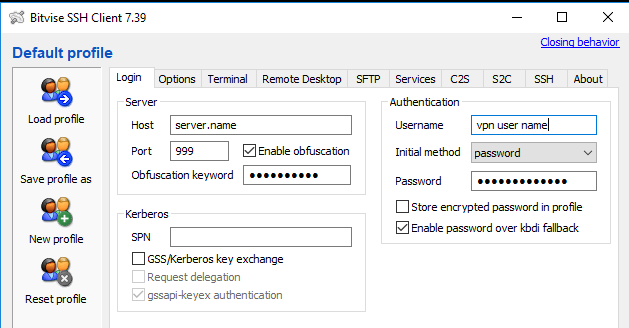
- #Bitvise ssh tunnel how to#
- #Bitvise ssh tunnel install#
- #Bitvise ssh tunnel password#
- #Bitvise ssh tunnel free#
One of the most advanced graphical SFTP clients.
#Bitvise ssh tunnel free#
It supports all desktop and server versions of Windows! Bitvise SSH Client is free to use!
#Bitvise ssh tunnel how to#
This tutorial shows how to set up a Bitvise client, but these steps can also be applied to Secure Pipes which works in much the same way.Bitvise SSH Client for Windows is a free SSH terminal, tunneling, and SFTP file transfer client with both graphical and scriptable command-line interfaces. You can close the Bitvise window now, which will minimize it to your notifications bar (on windows). You should now be able to log in to Epsilon and have the connection be automatically maintained by Bitvise. Set Listen Interface to localhost and listen port to 1080 (or whatever port you want)Īdd a new entry in your C2S tab, set listen interface to localhost, listen port to 2222 (or whatever port you want), and destination host:port to gimel:22. Set authentication method as "publickey", enter your passphrase and set "Client Key" to be the private key you just uploadedĬonfigure your SOCKS Proxy Forwarding Settings Navigate to "Client Key Manager" and import your private key file Navigate to "Host Key Manager" and import your public key file Setting up your Bitvise profile for Epsilon Add your public and private keys Since I am on Windows I use the Bitvise ssh client, but Secure Pipes has all the same features. Other necessary features include Client-to-Server port forwarding and SOCKS5 proxy forwarding. Both of these clients will automatically reconnect when their ssh connection is reset, and will also take care of entering your password/passphrase. To top it off, I've run into some issues while trying to chain sshpass and autossh together, which means this is an unreliable solution.īitvise (Windows) / Secure Pipes (Mac OS)īitvise/Secure Pipes are GUI ssh clients that have some very useful features for us.
#Bitvise ssh tunnel install#
Unfortunately the version of sshpass that is installed via apt-get or similar is incompatible with newer ssh clients- you will need to compile and install a newer version of sshpass from source.
#Bitvise ssh tunnel password#
The -p option does not have to be done in plain text, you can specify the password with a private file (-f) or via environmental variable (-e). When connecting to Epsilon this prompt is "Enter your passphrase" whereas with Gimel the prompt is "Enter your password". Sshpass -P "assphrase" -p autossh -i -CL localhost::gimel:22 -D -P option specifies the prompt sshpass should look for when it enters your password.
This can be chained together with autossh to set up an ssh connection that will automatically reconnect and enter your password when the connection is reset. Sshpass is a simple tool for ssh that will automatically enter your ssh password when it's prompted. However, if your private key is protected by a password, this will still require you to manually log in each time, which brings us to our next tool. If you're on Windows (like me) you can install it through your Linux Subsystem. Autossh can be installed on MacOS or Linux via the command line.

3 Bitvise (Windows) / Secure Pipes (Mac OS).This can become very tedious, but thankfully there are some tools that can help us. If your connection to Epsilon gets reset, you need to manually restart it each time. Ssh -i -p to Epsilon/Gimel via terminal works well enough, but has a pitfall- connection reset. Ssh -i -CL localhost::gimel:22 -D gives you a password prompt, if your private key is protected by password)įollowed by issuing the following command on another terminal, which will open a shell for us on the gimel server. Using ssh in the command line, this is accomplished like so: Additionally, we set up a SOCKS5 proxy tunnel so that we can view webpages local to the lab network with our browser.

When working on projects remotely, Lab members must log in to the Epsilon portal and forward one of their local ports to listen to port 22 on Gimel. With the Coronavirus not showing any signs of letting up, we need to be prepared to work on projects remotely for some time.


 0 kommentar(er)
0 kommentar(er)
